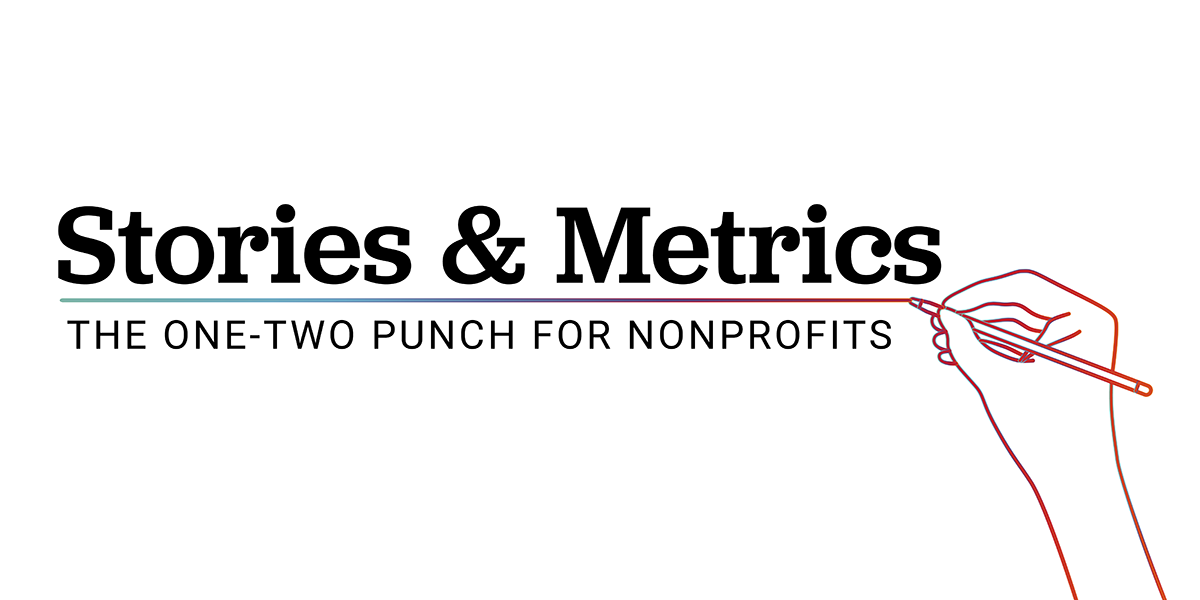Stories & Metrics: The One-Two Punch for Nonprofits
David Carnes | April 2021

What’s the best way for nonprofits to communicate the relevance and urgency of their work? You have many tools at your disposal. However, I think the most effective approaches can be broken down into two key areas: stories and metrics. You need stories to personalize your mission and describe the specific people, groups, and issues you’re dealing with. You need metrics to get across the hard numbers, which quantify your accomplishments. Let’s look more closely at how these two areas differ from yet complement one another.
Why Stories and Metrics Matter?
Both stories and metrics are essential for getting your message across.
Stories Engage the Emotions
The human brain is hardwired to respond to stories, which is why they’ve been with us since the dawn of history. Stories don’t only predate the internet, they predate written language. For nonprofits, stories let you show concrete examples of what you’re doing. Here are a few examples to illustrate the power of stories.

World Bicycle Relief — This organization, which provides bicycles to help people around the world, has a powerful story on its home page: How a Bicycle Changed the Life of a Widowed Dairy Farmer. Note how they lead with this story, rather than giving an abstract explanation of what they do. Readers can see immediately how a bicycle can transform someone’s life.
Steve Rummler Hope Network — This organization, supporting individuals impacted by the opioid crisis and ensuring they have access to compassionate, evidence-based treatment, uses stories to remove the stigma of opioid addiction.
Suicide Prevention Hotline — This organization, dedicated to suicide prevention, has a page featuring Stories of Hope and Recovery to convey how they save lives and help people cope with issues such as depression and addiction.
Feeding America — With an issue like hunger, it’s extremely powerful to illustrate the message with stories. The organization has a very compelling short video on YouTube, Real Stories of Hunger: Lamont, which has almost a million views. One of the first comments on the video is, “This is the best story I’ve ever heard.”
Metrics Provide the Hard Numbers
While stories let people see specific examples of what you do and how it impacts the world, data provide quantitative evidence. Stories work directly on emotions while metrics are processed by the intellect. Both are important when you want to communicate an important message. Let’s look at some examples of nonprofits sharing compelling data.
National Alliance to End Homelessness — This organization, in its mission to end homelessness, publishes a data-filled paper called State of Homelessness: 2020 Edition, which has lots of numbers and graphs to illustrate the severity of the problem. They start by pointing out the overall number of people experiencing homelessness in America and go on to break it down by demographics such as age, gender, and location.
Camfed — In its effort to help marginalized girls, Camfed presents some simple numbers explaining what donations can accomplish. For example, $15 provides a girl with essential supplies while $150 can keep a girl in high school for a whole year.
Emma Norton Service — Committed to promoting healing and recovery to women, individuals, and families who have experienced homelessness, Emma Norton Services shows the direct impact of your donation. We know that $500 will feed a resident for two months.
Ways to Obtain Metrics
Data is useful for planning your organization’s strategy and identifying the most pressing problems. It’s also valuable to share data with your audience to make them aware of the issues and what you’re doing to help. There are several ways to collect data.

Surveys
Surveys are one of the most straightforward ways to accumulate data. There are many survey tools that you can use to gather all kinds of information. Among the most popular are SurveyMonkey and Zoomerang. These and other applications give you a great deal of flexibility for creating surveys and polls with features that let you analyze the results and export them in PDF and Excel format.
Measuring Deliverables
It’s essential to track the measurable benefits achieved by your programs. This is necessary to better plan future projects as well as to communicate your effectiveness to the public and your membership. This may include the number of people receiving money or tangible goods from the program or the number of people participating.
Measuring Outcomes
Demonstrating outcomes is an extremely powerful way to build support for your organization. This can include a comparison between pre and post-program circumstances. For example, a literacy program can track how much test scores have risen. For an environmental organization, it may be related to metrics such as trees planted or a growing population of animals belonging to an endangered species. For a visually powerful example of this, see the Eden Reforestation Projects website, which has counter listing trees planted, project sites, and other metrics.
How to Balance Stories and Metrics
While we can discuss stories and metrics as distinct categories, it’s best not to think of them as separate. In fact, the most effective approach is to integrate them by incorporating data into your storytelling. Someone visiting your website or watching one of your videos is not consciously thinking about whether you’re focusing on metrics or stories. Your audience is affected by both. The more you can seamlessly balance these two approaches, the more effective and persuasive your campaigns will be.
Integrate Data Into Your Stories
Stories about individuals or specific events are good for engaging your audience. You can bolster the effect by adding data. One of our programs helped 592 vets start small businesses, a metric worth sharing. Josephine Anderson, who lost both her legs in Iraq, now employs two hundred other vets making state-of-the-art prosthetics. This is both a compelling story and one that includes relevant data as well.
Similarly, In the above example of World Bicycle Relief, the story focuses on one woman named Georgina. There’s some data about her specifically as well as a broader metric, that a bike increases income for dairy farmers by 23%.
Use Compelling Visuals
Visuals, including photographs, charts, graphs videos, and infographics are often an effective way to bridge data and stories. A photograph can often tell a compelling story independently of any text. Infographics are an eye-catching way to share complex data. Consider the infographic from Piedmont Healthcare, a nonprofit community healthcare service, describing how organ donation saves lives. It contains testimonials from both doctors and patients along with many compelling statistics, such as 21 people die every day waiting for a transplant.
An Effective Message Includes Both Stories and Metrics
When you combine data and stories, you reach your audience on both the emotional and intellectual levels. You let them see specific and personalized examples of your actions while also providing them with verifiable numbers.
ArcStone designs beautiful websites and provides customized marketing services for thoughtful brands and nonprofits. If you need help telling your nonprofit’s story with compelling metrics, contact us.
